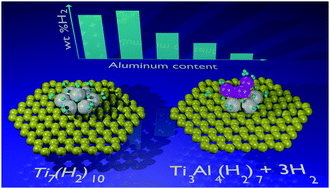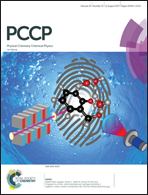Hydrogen storage in bimetallic Ti–Al sub-nanoclusters supported on graphene
Abstract
Recent studies suggest that graphene decorated with light metal atoms is a feasible alternative for the design of the next generation of hydrogen storage systems, that is, materials which require a gravimetric content of at least 7.5 wt%, and an adsorption energy of 0.2–0.6 eV per H2. We present a first principles study of hydrogen adsorption in titanium, and bimetallic Ti5−xAlx (x = 1–3) and Ti7−xAlx (x = 1–4) clusters supported on graphene. Our results for Ti5, Ti4Al, Ti7, and Ti6Al show that doping titanium clusters with small amounts of aluminum does not influence the cluster stability on graphene, but that notably, it enhances its hydrogen gravimetric content up to 3.2–3.6 wt%. A further increment of the aluminum concentration was found to reduce the cluster stability and to favor hydrogen desorption, as shown by our calculations for supported Ti3Al2, Ti2Al3, TiAl4 and Ti5Al2. An analysis of atomic charges and density of states reveals the role of charge transfer and orbital interactions in the stability of hydride and dihydrogen complexes in the studied systems. Our results support the hypothesis that a controlled introduction of small metal clusters to graphene is a feasible way to enhance its hydrogen gravimetric content, and it opens up the possibility of investigating other binary TMx–Ay (TM = transition metal and A = main group) clusters supported on graphene as promising candidates for hydrogen storage.



 Please wait while we load your content...
Please wait while we load your content...